Hearn E.J. Mechanics of Materials. Volume 1
Подождите немного. Документ загружается.

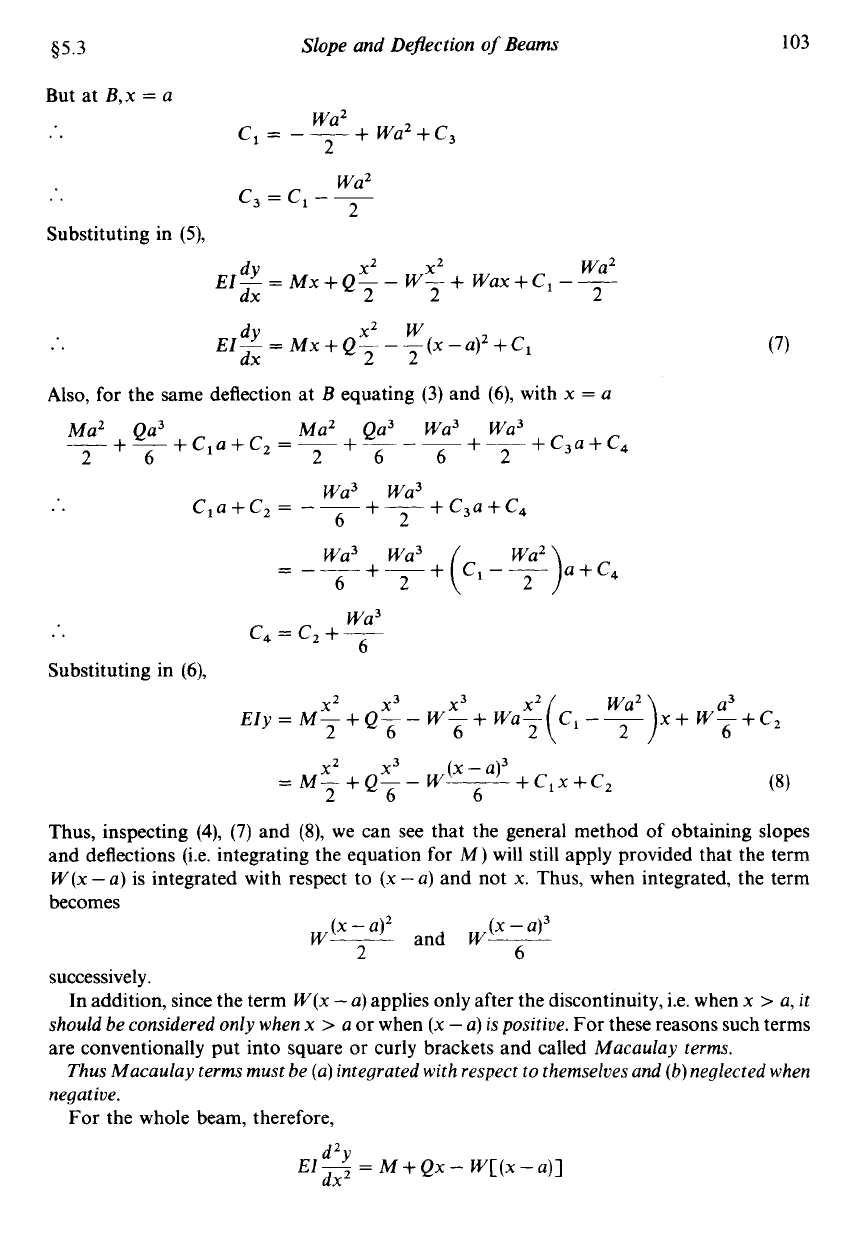
$5.3
Slope and Deflection
of
Beams
103
But at
B,x
=
a
..
Wa2
2
c
+
Wa2
+
C3
1-
L
Substituting in
(9,
..
dY
x2 x2 Wa2
El-=Mx+Q--
W-+
Wax+C,---
dx
2 2
2
dY
x2
w
El-
=
Mx
+
Q-
-
-(x-a)’
+C,
dx
22
Also,
for the same deflection at
B
equating (3) and
(6),
with
x
=
a
Ma2 Qa3 Ma2 Qa3 Wa3 Wa3
+
~
+
C3a
+
C,
-+-+C,a+C,
=-+----
2
6
2
6 6
2
..
..
Substituting in
(6),
Wa3 Wa3
+- +
C3a
+
C,
C,a+C2
=
--
2
6
=
-__
Wa3+wa3
+
(
c,---
y2)a+c,
6
2
Wa
c,=c2+-
6
(7)
x2 x3
(x
-
a)3
2
6
6
=
M-
+
Q-
-
W-
+
c,x
+
c,
Thus, inspecting
(4),
(7)
and
(8),
we can see that the general method of obtaining
slopes
and deflections (i.e. integrating the equation for
M)
will still apply provided that the term
W(x -a)
is integrated with respect to
(x -a)
and not
x.
Thus, when integrated, the term
becomes
(x
-
a)2
W-
2
(x
-
a)3
and
W-
6
successively.
In addition, since the term
W(x
-
a)
applies only after the discontinuity, i.e. when
x
>
a, it
should be considered only when
x
>
a
or
when
(x
-
a)
is
positive.
For
these reasons such terms
are conventionally put into square or curly brackets and called
Macaulay terms.
Thus Macaulay terms must be (a) integrated with respect
to
themselves and
(b)
neglected when
negative.
For the whole beam, therefore,
d2Y
El,
=
M+Qx- W[(x-a)]
dx
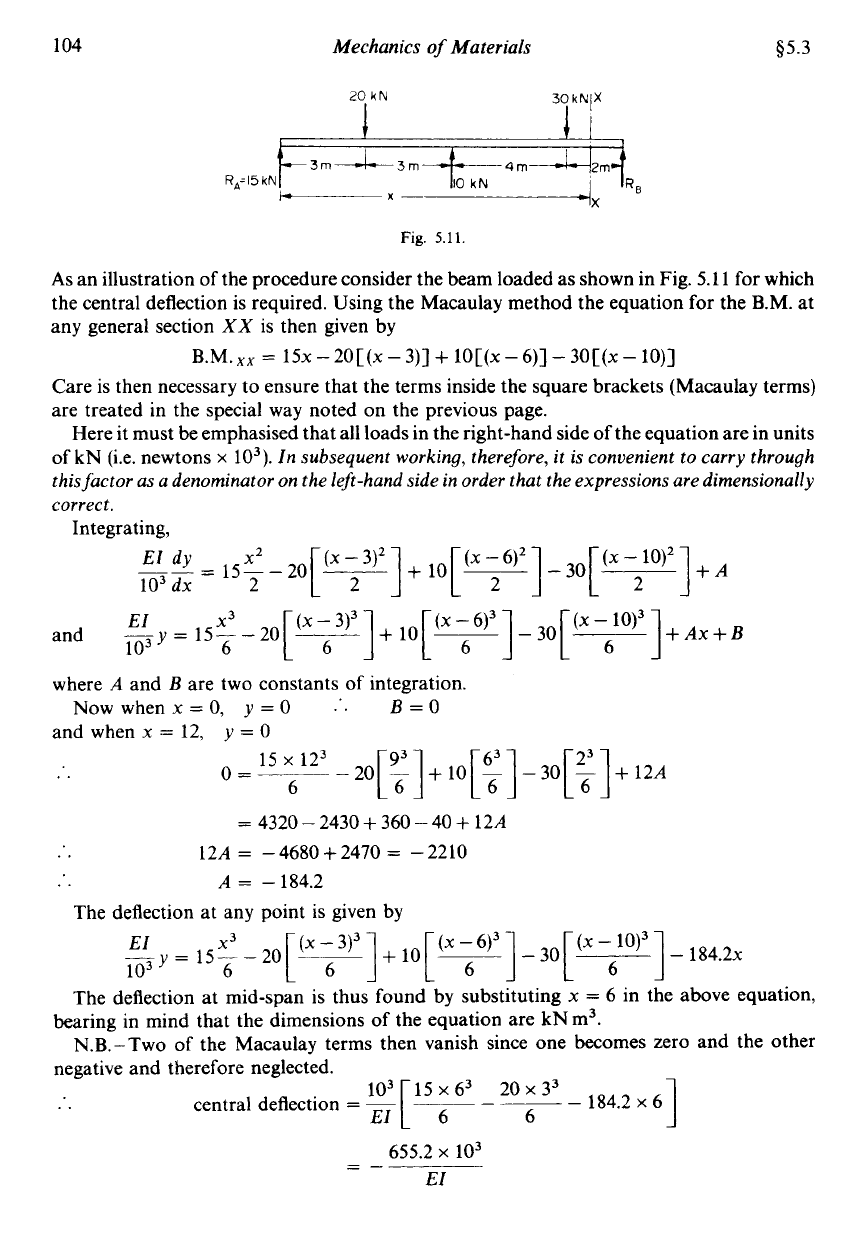
104
Mechanics
of
Materials
55.3
Fig.
5.11.
As
an illustration of the procedure consider the beam loaded as shown in Fig.
5.1
1
for which
the central deflection is required. Using the Macaulay method the equation for the B.M. at
any general section
XX
is then given by
Care is then necessary to ensure that the terms inside the square brackets (Macaulay terms)
are treated in the special way noted on the previous page.
Here it must be emphasised that all loads in the right-hand side
of
the equation are in units
of kN (i.e. newtons
x
lo3).
In
subsequent working, therefore,
it
is convenient to carry through
this factor as a denominator on the left-hand side
in
order that the expressions are dimensionally
correct.
B.M.
xx
=
15~
-
20[
(X
-
3)]
+
10[(~
-
6)]
-
30[
(X
-
lo)]
Integrating,
--=15--20[~]+10[~]-30[(
El
dy
x2
x
-
3)2
x
-
6)2
x
-
10)2
]+A
lo3
dx
2
E1
x3
x
-
3)3
x
-
6)3
x
-
1013
and
~
lo3’= 15- 6
-
20
[
51
+
10
[
+]
-
30[
(
]
+
Ax
+
B
where
A
and
B
are two constants
of
integration.
Now when
x
=0,
y
=O
.’.
B
=O
and when
x
=
12,
y
=
0
15
x
123
..
o=--
6
=
4320
-
2430
+
360
-
40
+
12A
..
..
A
=
-
184.2
12A
=
-4680+2470
=
-2210
The deflection at any point is given by
x3
x
-
3)3
x
-
6)3
-
1013
E1
Sy=
6
15-
-
20[%]
+
IO[
$1
-
30[
(
]
-
184.2~
The deflection at mid-span is thus found by substituting
x
=
6
in the above equation,
N.B.-Two of the Macaulay terms then vanish since one becomes zero and the other
bearing in mind that the dimensions
of
the equation are kNm3.
negative and therefore neglected.
..
central deflection
=
655.2
x
lo3
E1
-_
-
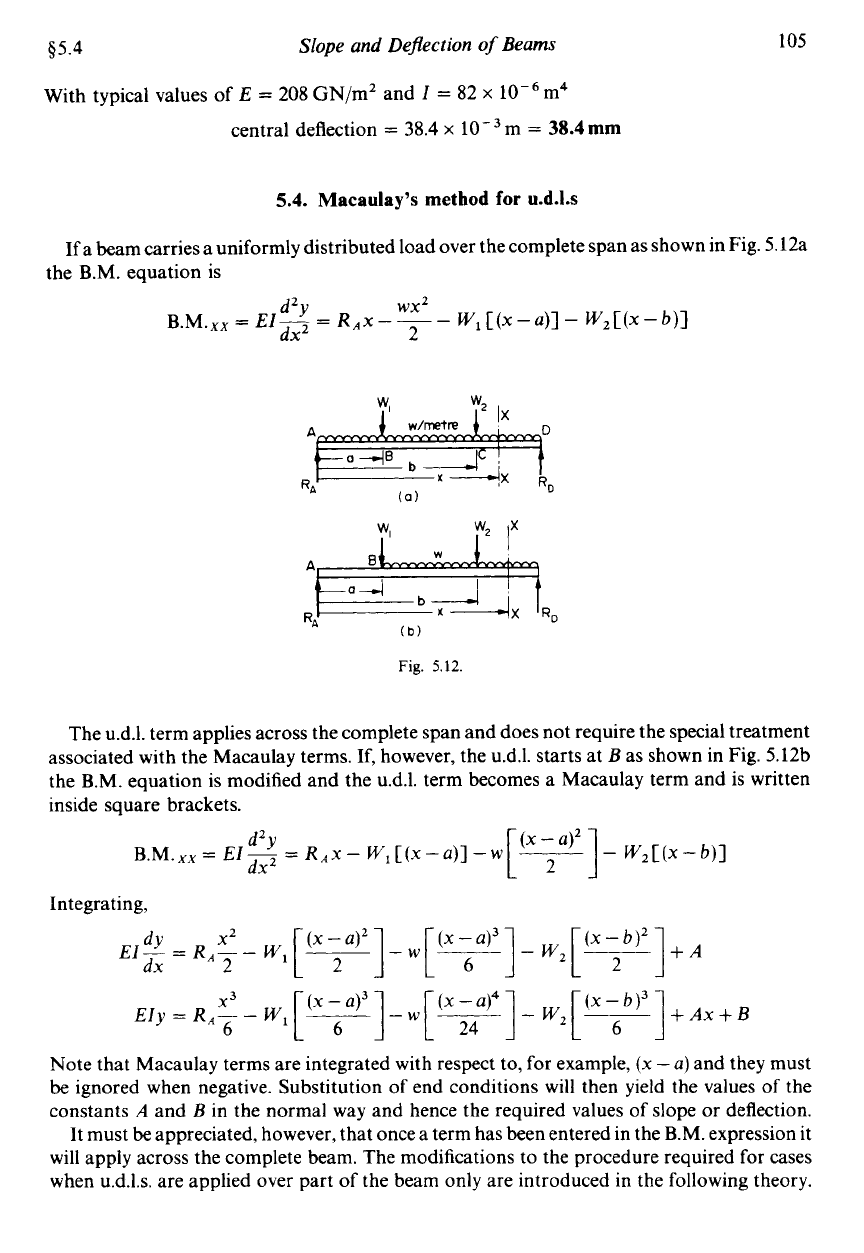
45.4
With typical values of
E
=
208 GN/m2 and
I
=
82
x
Slope
and
Defection
of
Beams
m4
central deflection
=
38.4
x
lo-’
m
=
38.4
mm
105
5.4.
Macaulay’s
method
for
u.d.1.s
If a beam carries a uniformly distributed load over the complete span as shown in Fig. 5.12a
the B.M. equation is
d2Y
wx2
B.M.xx=
EI-= RAx--- W,[(x-a)]- W2[(x-b)]
dx2
2
W
W,
A
A,
B
Fig.
5.12.
The u.d.1. term applies across the complete span and does not require the special treatment
associated with the Macaulay terms.
If,
however, the u.d.1. starts at
B
as shown in Fig. 5.12b
the B.M. equation is modified and the u.d.1. term becomes a Macaulay term and is written
inside square brackets.
d2Y
B.M.xx=El,=RAx-W,[(x-a)]-w
dx
Integrating,
dy
x2
EI-
=
RA-
-
dx
2
x3 x
-
a)3
6
Ely
=
RA-
-
W,
[&-I
-
w
(x
-a)’
6
Note that Macaulay terms are integrated with respect to, for example,
(x
-a)
and they must
be
ignored when negative. Substitution of end conditions will then yield the values of the
constants
A
and
B
in the normal way and hence the required values of slope or deflection.
It must be appreciated, however, that once a term has been entered in the B.M. expression it
will apply across the complete beam. The modifications to the procedure required for cases
when u.d.1.s. are applied over part of the beam only are introduced in the following theory.
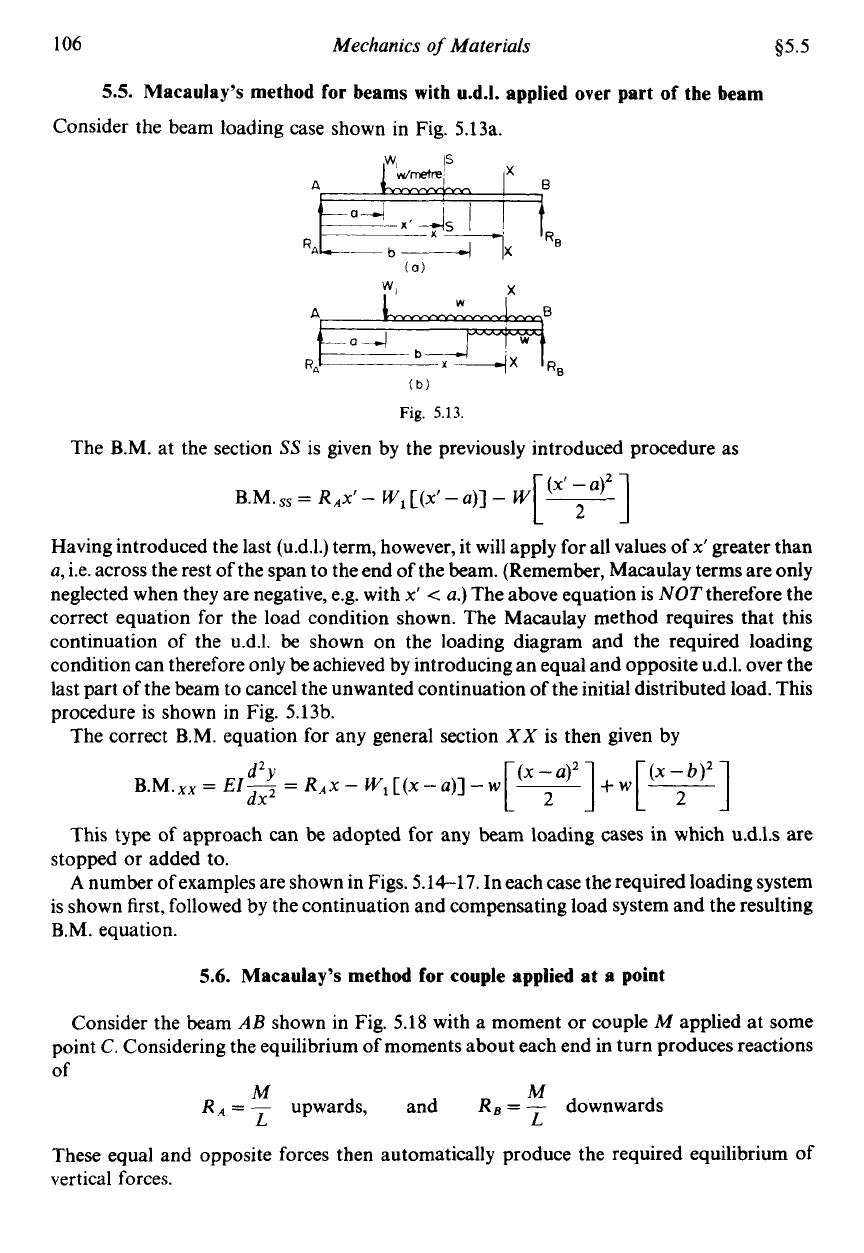
106
Mechanics
of
Materials
45.5
5.5.
Macaulay's method for beams with u.d.1. applied over part of the beam
Consider the beam loading case shown in Fig. 5.13a.
X
A
I
Fig.
5.13.
The B.M. at the section
SS
is given by the previously introduced procedure as
B.M.ss=
RAx'- W,[(x'-a)]- W
-
['"'
a)2
1
Having introduced the last (u.d.1.) term, however, it will apply for all values of
x'
greater than
a,
i.e. across the rest of the span to the end of the beam. (Remember, Macaulay terms are only
neglected when they are negative, e.g. with
x'
<
a.)
The above equation is
NOT
therefore the
correct equation for the load condition shown. The Macaulay method requires that this
continuation of the u.d.1. be shown on the loading diagram and the required loading
condition can therefore only
be
achieved
by
introducing an equal and opposite u.d.1. over the
last part of the beam to cancel the unwanted continuation
of
the initial distributed load. This
procedure is shown in Fig. 5.13b.
The correct B.M. equation for any general section
XX
is then given by
d2Y
B.M.xx=
EZ7
=
RAx- W,[(x-a)]-w
dx
This type of approach can be adopted for any beam loading cases in which u.d.1.s are
stopped or added to.
A
number of examples are shown in Figs. 5.14-17. In each case the required loading system
is shown first, followed by the continuation and compensating load system and the resulting
B.M.
equation.
5.6.
Macaulay's method for couple applied at
a
point
Consider the beam
AB
shown in Fig. 5.18 with a moment or couple
M
applied at some
point
C.
Considering the equilibrium of moments about each end in turn produces reactions
of
M
downwards
RA=x
upwards, and
RB=L
M
These equal and opposite forces then automatically produce the required equilibrium of
vertical forces.
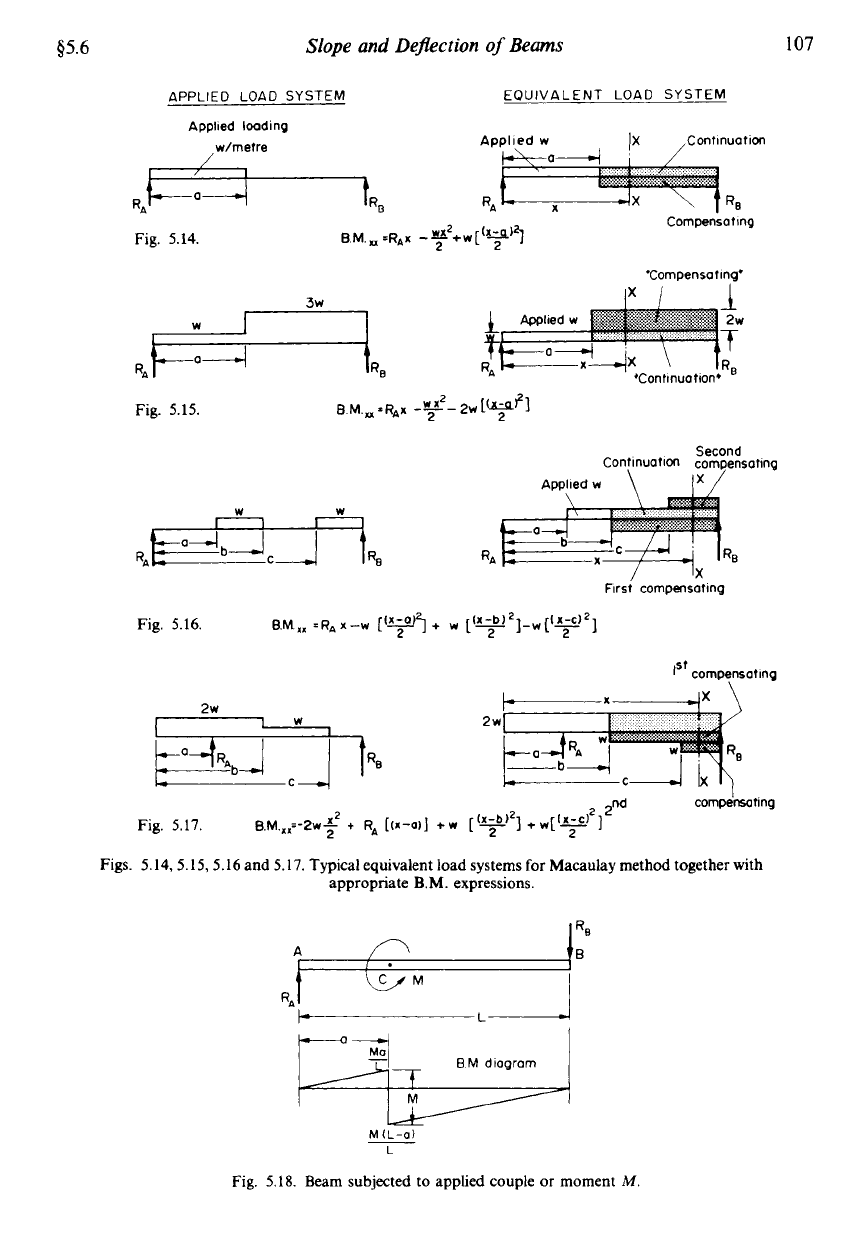
$5.6
Slope
and
Depection
of
Beams
107
APPLIED
LOAD
SYSTEM
EQUIVALENT
LOAD SYSTEM
Applied loading
w/metre
Continuation
lx
/
Applied
w
++-a4
RA
Compensating
EM
-H2+w[('a'?
2
2
RA
E%-lRB
Fig
5
14
+Compensating'
I
T
RA
RE RE
2w
Fig.
5.15.
8
M.,
=RAx
-e2-
2
2w
[??I
Second
RA
First compensating
Fig
5
16.
EMxx
;R,X-W
[I&&
+
w
['?*]-W[(?)~]
is'
compensating
2w
compensatlng
2
2"d
BM,,=-2wL2
t
RA
[(a-a)]
+w
[(X-b"]
+w['x-c'
1
2
2
2
Fig.
5
17.
Figs
5
14,5
15,5
16 and 5.17. Typical equivalent load systems for Macaulay method together with
appropnate
B
M.
expressions
A
n
B
M
diagram
MIL-a1
L
Fig.
5.18.
Beam subjected to applied couple
or
moment
M.
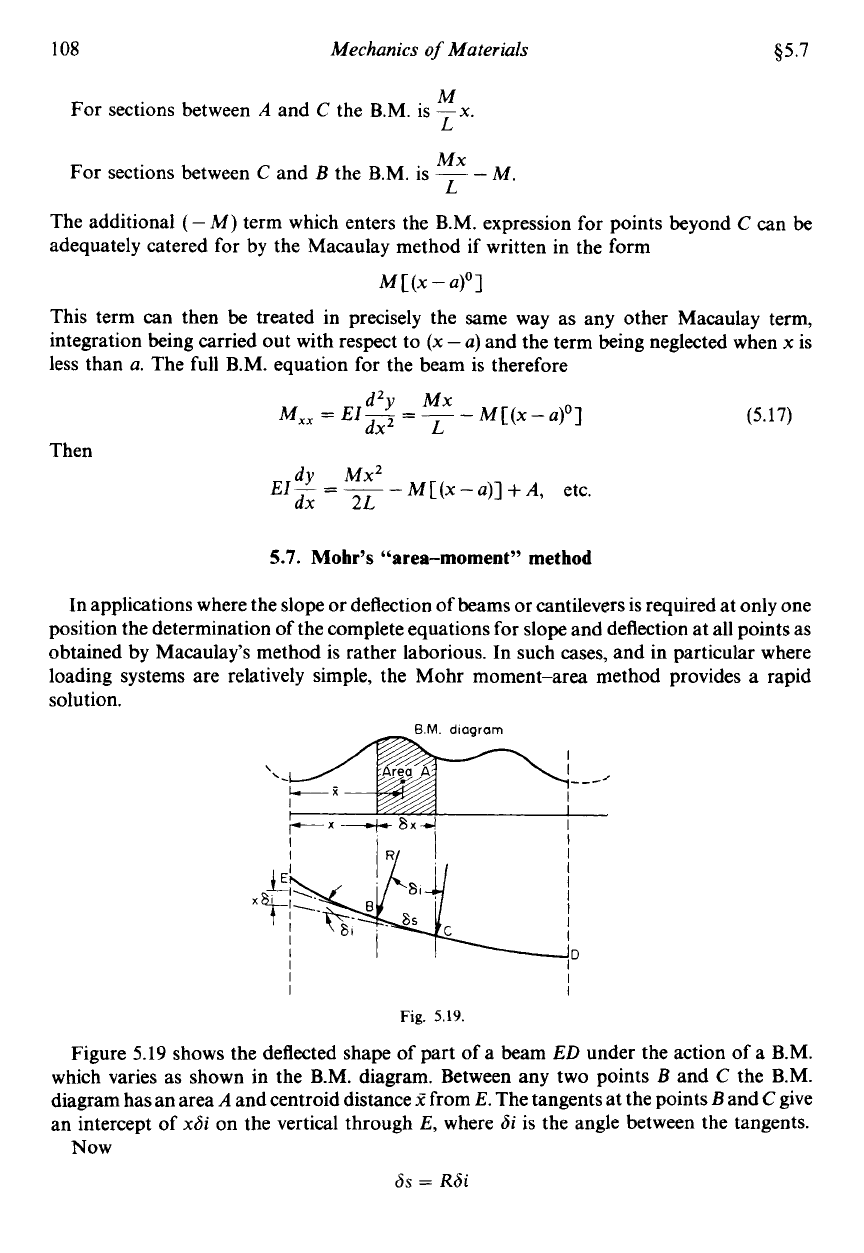
108
Mechanics
of
Materials
45.7
M
L
For sections between
A
and
C
the B.M. is
-x.
Mx
L
For sections between
C
and
B
the B.M. is ~
-
M
The additional
(-
M)
term which enters the B.M. expression for points beyond
C
can
be
adequately catered for by the Macaulay method if written in the form
M[I(x-a)Ol
This term can then
be
treated in precisely the same way as any other Macaulay term,
integration being carried out with respect to
(x
-
a)
and the term being neglected when
x
is
less than
a.
The full B.M. equation for the beam is therefore
d2y Mx
dx2
L
M,,=EI-=--M[(x-a)0]
(5.17)
Then
dy Mx2
dx
2L
El-
=
-
-
M[(x-a)]+A,
etc.
5.7.
Mohr’s “area-moment” method
In applications where the slope or deflection of beams or cantilevers is required at only one
position the determination of the complete equations for
slope
and deflection at all points as
obtained
by
Macaulay’s method is rather laborious. In such cases, and in particular where
loading systems are relatively simple, the Mohr moment-area method provides a rapid
solution.
\
‘-
B.M.
diagram
I
I
I
17
I/
I
I
I
I
I
Fig.
5.19.
Figure
5.19
shows the deflected shape of part of a beam
ED
under the action of a B.M.
which varies as shown in the B.M. diagram. Between any two points
B
and
C
the B.M.
diagram has an area
A
and centroid distance
X
from
E.
The tangents at the points B and
C
give
an intercept
of
xSi
on the vertical through
E,
where
Si
is the angle between the tangents.
6s
=
R6i
Now
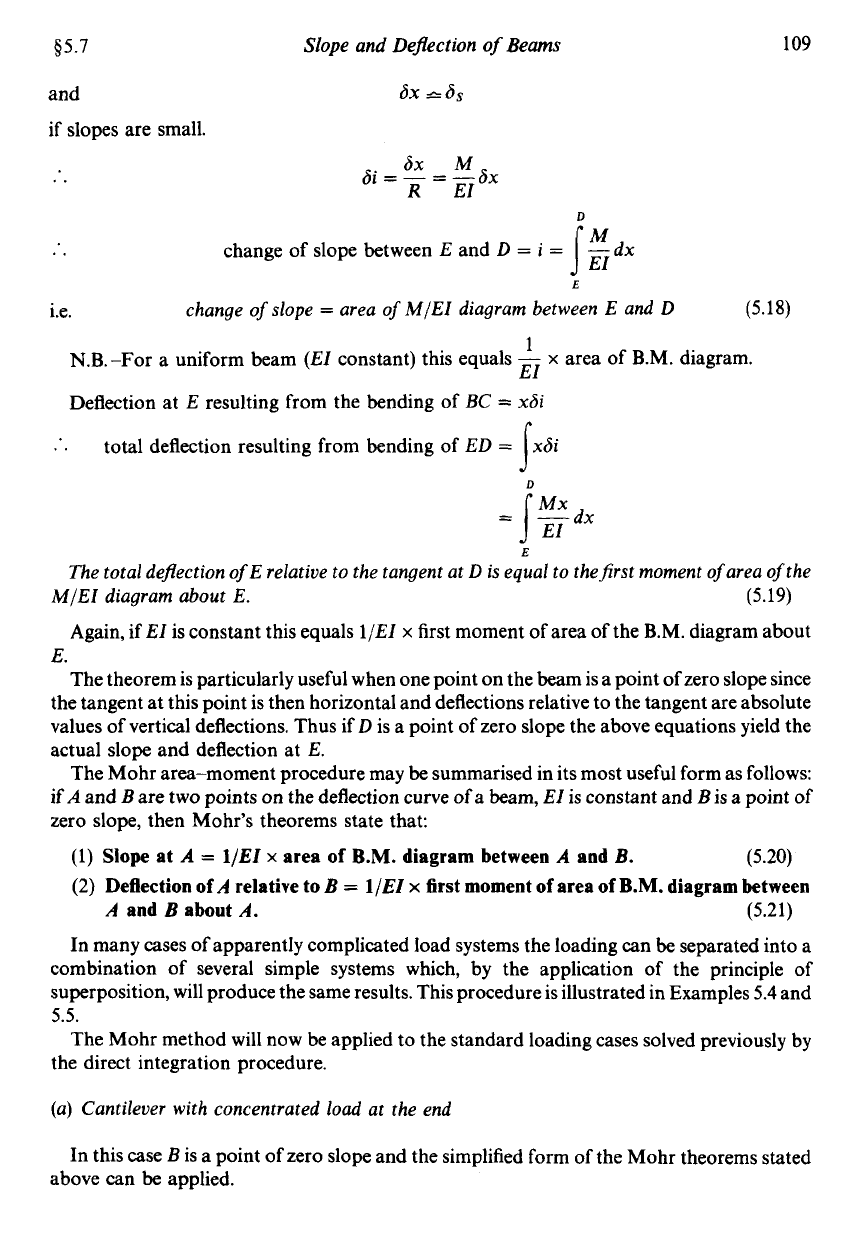
85.1
Slope and Deflection
of
Beams
109
and
6x
-6s
if slopes are small.
change of slope between E and D
=
i
=
-dx
..
jk
i.e.
change
of
slope
=
area
of
M/EI
diagram between
E
and
D
(5.18)
1
El
N.B.-For a uniform beam
(El
constant) this equals
-
x
area of B.M. diagram.
Deflection at
E
resulting from the bending of
BC
=
x6i
...
total deflection resulting from bending of ED
=
The total deflection
of
E
relative to the tangent
at
D
is equal to the$rst moment
of
area
of
the
Again, if
El
is constant this equals 1/EI
x
first moment of area of the
B.M.
diagram about
E.
The theorem is particularly useful when one point on the beam is a point of zero slope since
the tangent at this point is then horizontal and deflections relative to the tangent are absolute
values of vertical deflections. Thus if D is a point of zero slope the above equations yield the
actual slope and deflection at
E.
The Mohr area-moment procedure may
be
summarised in its most useful form as follows:
if
A
and Bare two points on the deflection curve
of
a beam,
El
is constant and
B
is a point of
zero slope, then Mohr's theorems state that:
MIEI
diagram about
E. (5.19)
(1)
Slope at
A
=
l/EZ
x
area
of
B.M.
diagram between
A
and
B.
(2)
Deflection
of
A
relative to
B
=
1/EZ
x
first moment
of
area
of
B.M.
diagram between
In many cases of apparently complicated load systems the loading can
be
separated into a
combination of several simple systems which, by the application of the principle of
superposition, will produce the same results. This procedure is illustrated in Examples
5.4
and
5.5.
The Mohr method will now be applied to the standard loading cases solved previously by
the direct integration procedure.
(5.20)
(5.21)
A
and
B
about
A.
(a) Cantilever with concentrated
load
at the end
In this case
B
is a point
of
zero slope and the simplified form of the Mohr theorems stated
above can be applied.
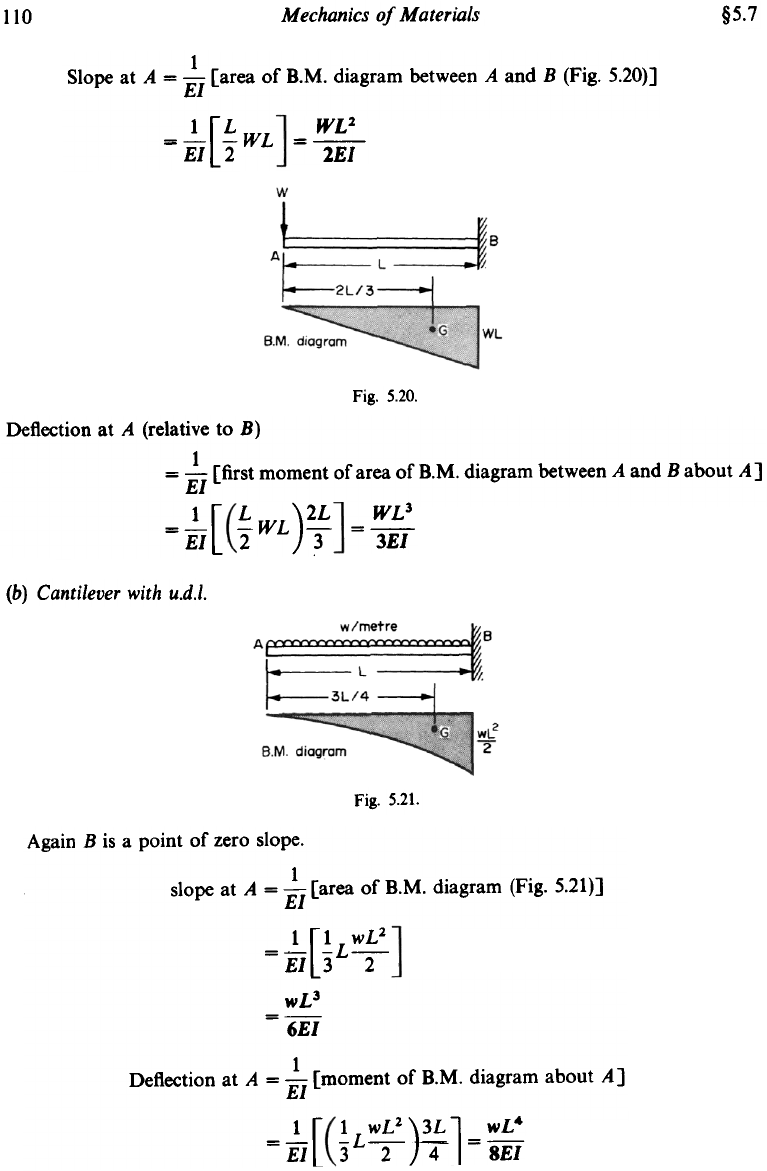
Mechanics of Materials
§5.7
110
Slope at A = ~ [area of B.M. diagram between A and B (Fig. 5.20)]
=~
[~WL
El 2
WL2
--
-1.EI
w
A~'
1-2L/3
B.M. diagram
Fig. 5.20.
Deflection at A (relative to B)
= ~ [first moment of area of B.M. diagram between A and B about A ]
1
[ WLJ
=El =JET
~ WL
) ~
2 3
(b) Cantilever with u.d.l.
Fig. 5.21.
Again B is a point of zero slope.
slope at A = ~ [area of B.M. diagram (Fig. 5.21)]
El
= ~
[!L~
El 3 2
wL3
-6El
Deflection at A = b [moment of B.M. diagram about A]
=b[ ~L~)~J=*
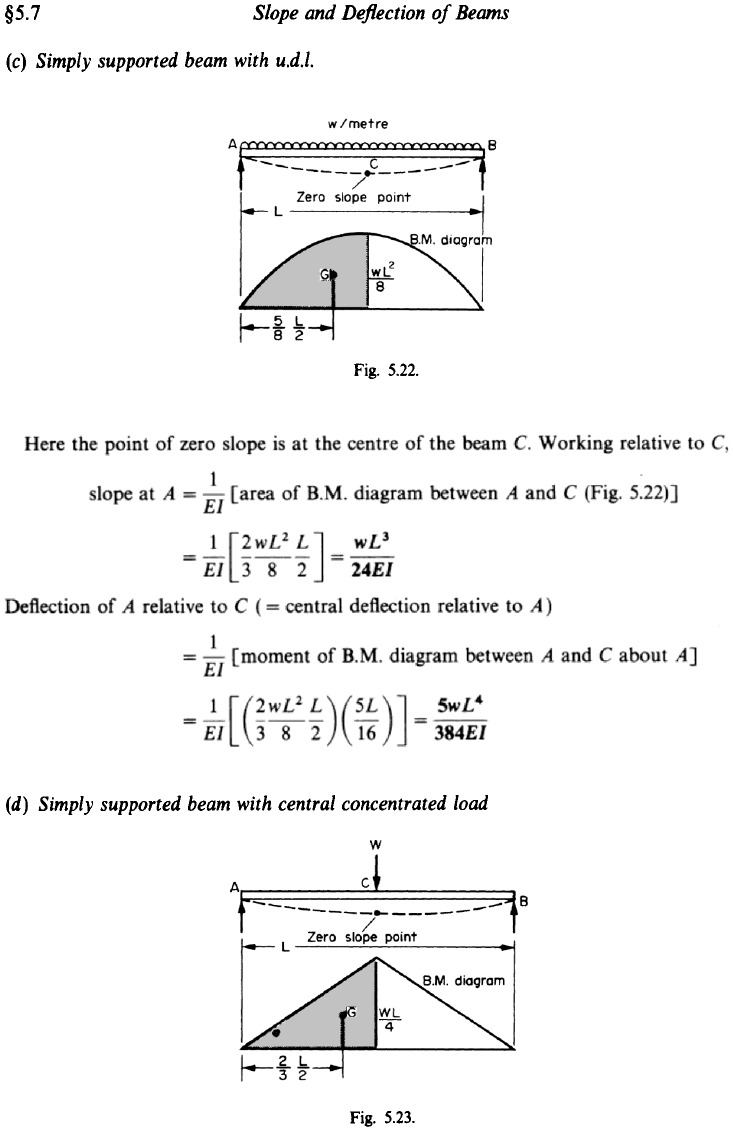
§5.7
Slope and Deflection of Beams
(c) Simply supported beam with u.d.l.
Fig. 5.22.
(d) Simply supported beam with central concentrated load
Fig. 5.23.
111
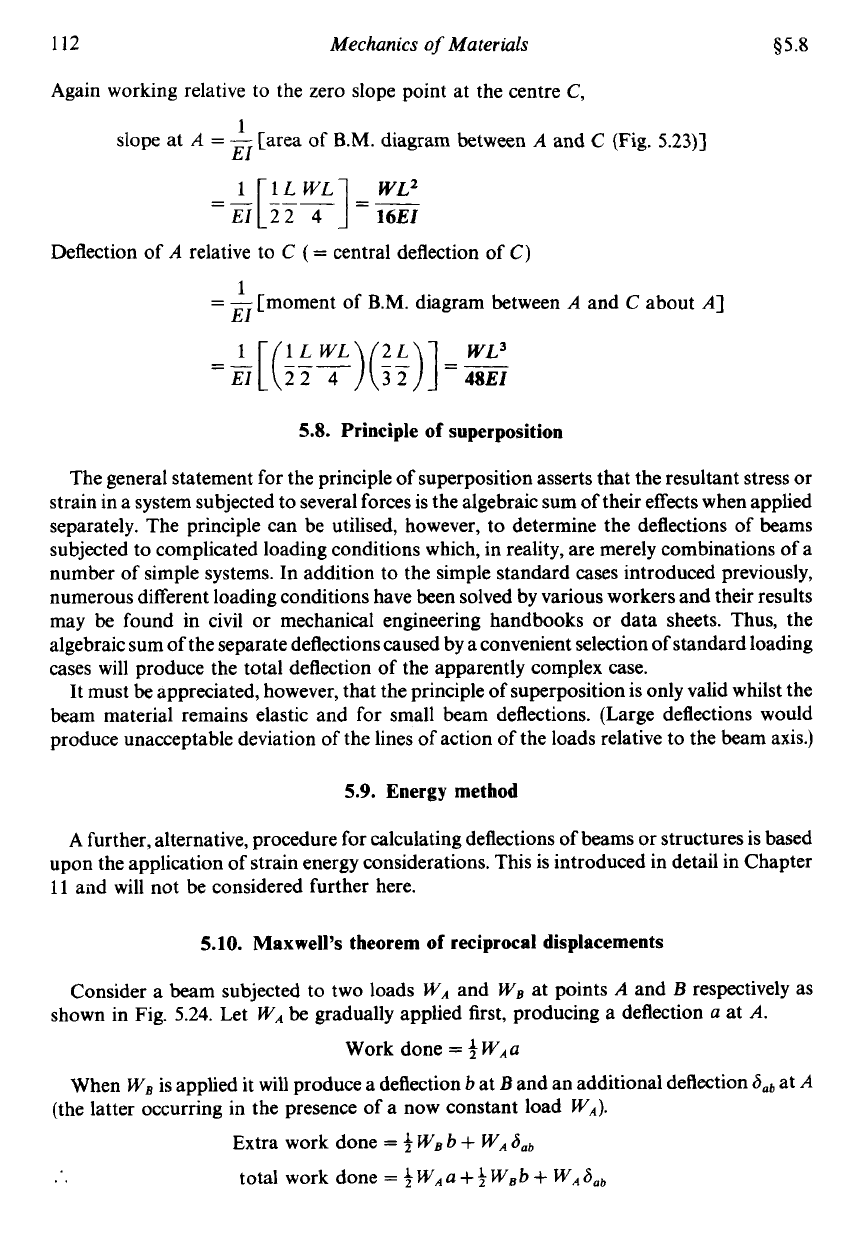
112
Mechanics
of
Materials
$5.8
Again working relative to the zero slope point at the centre
C,
1
El
slope at
A
=
-
[area of
B.M.
diagram between
A
and
C
(Fig. 5.23)]
16EZ
Deflection of
A
relative to
C
(=
central deflection of
C)
1
El
=
-[moment of
B.M.
diagram between
A
and
C
about
A]
1LWL
WL3
=
&
[
(z;iq)(
E)]
=
48EI
5.8.
Principle
of
superposition
The general statement for the principle of superposition asserts that the resultant stress or
strain in a system subjected to several forces is the algebraic sum of their effects when applied
separately. The principle can be utilised, however, to determine the deflections of beams
subjected to complicated loading conditions which, in reality, are merely combinations of a
number of simple systems. In addition to the simple standard cases introduced previously,
numerous different loading conditions have been solved by various workers and their results
may be found in civil or mechanical engineering handbooks
or
data sheets. Thus, the
algebraic sum of the separate deflections caused by a convenient selection of standard loading
cases will produce the total deflection of the apparently complex case.
It must be appreciated, however, that the principle of superposition is only valid whilst the
beam material remains elastic and for small beam deflections. (Large deflections would
produce unacceptable deviation of the lines of action of the loads relative to the beam axis.)
5.9.
Energy method
A
further, alternative, procedure for calculating deflections
of
beams or structures is based
upon the application
of
strain energy considerations. This is introduced in detail in Chapter
11
aild will not be considered further here.
5.10.
Maxwell’s theorem
of
reciprocal displacements
Consider a beam subjected to two loads
WA
and
WB
at points
A
and B respectively as
shown in Fig. 5.24. Let
WA
be gradually applied first, producing a deflection
a
at
A.
Work done
=
3
WAa
When
WB
is applied
it
will produce a deflection
b
at Band an additional deflection
6,,
at
A
(the latter occurring in the presence of a now constant load
WJ.
Extra work done
=
3
WB
b
+
WA
dab
..
total work done
=
f
WA a
+
3J
WB
b
+
WA
a,,
